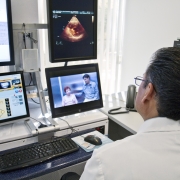Leaving the comforts of a salaried, nine-to-five office job and entering the world of freelance work was an exciting decision for me. But it also presents some unexpected challenges when it came to health care.
As someone who has always enjoyed employer-provided health benefits, the prospect of having to pay out of pocket for medical expenses was not something of which I had any prior knowledge. But finding myself in a position where I was more or less forced to get creative about my health care options has been an eye-opening experience.
As my last day in a traditional office setting drew closer, I began to worry about losing my health insurance. Making sure all my ducks were in a row, I placed one final order of contact lenses before I joined the ranks of the uninsured.
Feeling rather proud of myself for getting ahead of the problem, I was disheartened when 1-800 Contacts emailed me to let me know that they could not fill my order. While my prescription was still good for another month, the brand my doctor had prescribed to me had been discontinued. Normally, this would be an easy fix. All I needed to do was call my optometrist and have him write me a new prescription for a different brand.
But unfortunately, my regular doctor was not able to get me in for an appointment until after my insurance coverage ended. And without optical benefits, paying for a routine eye examination was going to be a huge financial burden. Luckily, the wonders of technology have given options to those who, like myself, find themselves without health insurance.
Another Option
Without vision coverage, getting a new prescription for contact lenses was going to cost me several hundred dollars. And with only two lenses remaining in my reserves, my time and my options were severely limited.
After explaining my plight to a 1-800 Contacts customer service representative, he quickly responded that there were other options available. So long as I had ten minutes to spare, I would be able to take an eye examination online from Opternative for only $50. This seemed too good to be true and my first thought was: “is this legal?”
While some states do prohibit online examinations, many have embraced the practice. Not only is this more convenient for millennials, who are infamously flaky when it comes to visiting the doctor, but it has also helped to drive costs down significantly. A visit to an optometrist will cost you anywhere from $200-$300 without insurance. And even with insurance, it is often still well over $100. And this usually does not include the actual cost of contact lenses or glasses.
To be fair, chains like Target and Walmart have both offered similar services at varying locations, but this still requires an in-person visit. But for someone like myself who is both busy and carless, allowing this process to take place in the comfort of my own home is a huge benefit.
While sites like Opternative and its competitors offer affordable eye exams, their purpose is restricted to the prescription of glasses and contact lenses. This means that they cannot do a full checkup to make sure that your eyes are healthy, which is still an important element to an annual visit. But with the growth telemedicine has seen over the last several years, it may only be a matter of time before this is possible. And for those whose most pressing needs are new glasses or contact lenses, online eye examinations are huge game changers.
And while it is certainly wise to regularly see an optometrist to ensure the health of your eyes, for those who cannot afford such a costly endeavor, online eye exams offer a viable alternative.
How Does it Work?
As soon as I signed up and made an account, the site asked me to sync my phone with my computer in order to use my phone to submit answers for the vision test. The app then asks you to turn the lights down during the vision test, just like in an actual optometrist office. I was then prompted to give my shoe size, which seemed a bit odd, but this is how the site determines how many steps you should take away from your computer screen to ensure quality results. After measuring the proper distance between you and your computer screen, the guided test is ready to begin.
Just as in a doctor’s office, you cover one eye and read the letters on the chart, but instead of responding to the doctor, you submit your answer on your smartphone.
After the test is complete, which typically takes about ten minutes, your responses are sent to an optometrist where they are reviewed. Shortly thereafter, you will receive an email with your prescription.
When all was said and done, the entire process, including receiving the new prescription, took less than an hour and saved me hundreds of dollars. And thanks to the free market, there has also been an increase in subscription-based contact lens services that will ship contacts to you each month for a nominal fee. Where one box of contact bi-weekly contact lenses can cost upwards of $40, brands like Hubble ship daily use contacts to its users for only $36 each month.
While many consumers have been using and loving these digital services, large companies like Johnson & Johnson, who produce 40 percent of the world’s contact lenses, and the American Optometric Association have actually lobbied congress in an attempt to rein in digital eye exams. The companies have stated safety concerns as the reasoning behind this endeavor. But the reality of the situation is that these companies have enjoyed not having to compete in this sector. But just like cabs now have to compete with Uber and hotels have to compete with Airbnb, the decentralization of vision care is resulting in protectionism on behalf of the giants of the prescription lens world.
When it comes to health care, individuals are eager to try things differently. And in our modern, digital era, telemedicine is convenient and accessible.
As the workforce continues to see a rise in contractors and digital nomads, it will be increasingly important to find ways to accommodate those whose employment status does not come with health benefits. Thankfully, digital eye exams offered through companies like Opternative and subscription-based services like Hubble are helping to decentralize vision coverage, making it more affordable and accessible to everyone, whether they have insurance or not.













